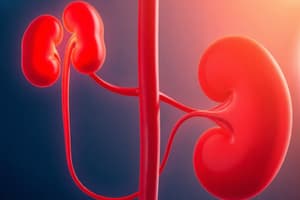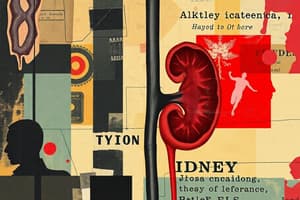Podcast
Questions and Answers
Which of the following is a function of the kidneys?
Which of the following is a function of the kidneys?
- Production of insulin
- Storage of glycogen
- Digestion of fats
- Regulation of serum osmolality (correct)
Secretion of which hormone is a kidney function?
Secretion of which hormone is a kidney function?
- Cortisol
- Melatonin
- Insulin
- Renin (correct)
What is the term for kidney failure or kidney insufficiency?
What is the term for kidney failure or kidney insufficiency?
- CHF
- TBI
- CRF/CRI (correct)
- COPD
Which cardiovascular issue is associated with chronic renal failure?
Which cardiovascular issue is associated with chronic renal failure?
What percentage of deaths in End Stage Renal Disease (ESRD) are accounted for by cardiovascular complications?
What percentage of deaths in End Stage Renal Disease (ESRD) are accounted for by cardiovascular complications?
Which of the following is a potential treatment for renal failure?
Which of the following is a potential treatment for renal failure?
What type of exercise is considered safe for patients with chronic kidney disease?
What type of exercise is considered safe for patients with chronic kidney disease?
What is a possible consideration related to bone health for patients with renal failure?
What is a possible consideration related to bone health for patients with renal failure?
Which of the following may not be a reliable indicator of exercise intensity in patients with renal failure?
Which of the following may not be a reliable indicator of exercise intensity in patients with renal failure?
Which vascular abnormality is associated with Collagen Vascular Disease?
Which vascular abnormality is associated with Collagen Vascular Disease?
Which type of tissue is affected by Collagen Vascular Disease?
Which type of tissue is affected by Collagen Vascular Disease?
What genetic abnormality is associated with Marfan's Syndrome?
What genetic abnormality is associated with Marfan's Syndrome?
What part of the body is affected in Marfan's Syndrome?
What part of the body is affected in Marfan's Syndrome?
What type of damage is caused by radiation (XRT)?
What type of damage is caused by radiation (XRT)?
Which treatment can have an effect on hematopoiesis?
Which treatment can have an effect on hematopoiesis?
Which of the following conditions is classified as a hematologic disorder?
Which of the following conditions is classified as a hematologic disorder?
What is the purpose of compensatory mechanisms in anemia?
What is the purpose of compensatory mechanisms in anemia?
Pulmonary complications are common with which of the following conditions?
Pulmonary complications are common with which of the following conditions?
What is a consideration in hot environments?
What is a consideration in hot environments?
What factor is associated with High Altitude?
What factor is associated with High Altitude?
Flashcards
Kidney Functions
Kidney Functions
Regulating extracellular fluid volume, serum osmolality, electrolyte and acid-base balance, secretion of renin and erythropoietin.
Chronic Renal Failure/Insufficiency
Chronic Renal Failure/Insufficiency
A condition where kidney function declines over time, potentially leading to multiple major complications such as hypertension and anemia.
End Stage Renal Disease (ESRD)
End Stage Renal Disease (ESRD)
The final stage of chronic kidney disease where the kidneys can no longer function on their own.
Dialysis
Dialysis
Signup and view all the flashcards
Compensatory mechanisms for anemia
Compensatory mechanisms for anemia
Signup and view all the flashcards
Connective Tissue Diseases
Connective Tissue Diseases
Signup and view all the flashcards
Marfan's Syndrome
Marfan's Syndrome
Signup and view all the flashcards
Hyperthermia
Hyperthermia
Signup and view all the flashcards
High Altitude
High Altitude
Signup and view all the flashcards
High Altitude risks
High Altitude risks
Signup and view all the flashcards
Study Notes
- The following are study notes based on the provided images.
Renal Function
- Kidney functions include regulating extracellular fluid volume, serum osmolality, electrolyte and acid-base balance and secretion of Renin and Erythropoietin.
- Disturbed kidney function can affect almost every other system in the body.
- Chronic Renal Failure/Insufficiency (CRF, CRI) has multiple major complications, especially with the kidneys.
- CRF/CRI can lead to hypertension (HTN), pericarditis, pericardial effusion, tamponade, anemia, bleeding disorders, myopathy, and peripheral neuropathy.
Renal Failure
- End Stage Renal Disease (ESRD) includes cardiovascular complications that account for 50% of deaths, including MI, CHF, and CVA.
- Hypertension is both a cause and a consequence of renal disease.
- Treatments for renal failure include conservative management, transplant, control of diet, fluid balance, BP, and mineral metabolism.
- Dialysis replaces the excretory functions of the kidney, including Hemodialysis (HD) and Peritoneal dialysis (PD).
- In chronic kidney disease, patients tend to have low functional capacity which is about 50% compared to healthy, age and sex-matched controls.
- Research indicates exercise performed safely before, during, or after HD can benefit patients.
- Exercise can increase VO2max by 20-25% in 10 weeks to 1 year of treatment
- Exercise can improve lipid profiles, BP control, insulin sensitivity, glucose metabolism, RBC count, and muscle strength.
Exercise Considerations for Patients with Renal Failure
- When starting exercises with patients in renal failure, begin with low intensity and gradually increase based on patient tolerance.
- Rating of Perceived Exertion (RPE) should be used because heart rate (HR) may not be a reliable indicator of exercise intensity.
- Influencing factors include anemia, impaired cardiac function, deconditioning, abnormal peripheral metabolism, and systemic function during exercise.
- Leg fatigue is a common complaint for these patients.
- Precautions include monitoring vital signs, adjusting routines based on daily symptoms, and awareness of medications and side effects.
- Consider the arm with the AV fistula and possible bone issues related to calcium/phosphorus balance.
- Possible bone issues come with long-term dialysis patients relating to calcium and phosphorus imbalance.
Collagen Vascular Disease
- Collagen Vascular Disease is a diverse group of systemic diseases.
- Vascular abnormalities are diffuse and variable.
- Joint, muscle, and connective tissue lesions are inflammatory.
- Collagen vascular diseases have the highest mortality and morbidity rates and affect kidneys, heart, and brain.
- Can affect all elements of the respiratory system: muscles, pleura, airways, vessels, interstitium.
- Specific cardiopulmonary involvement is related to RA, Lupus, ankylosing spondylosis, and progressive systemic sclerosis.
Connective Tissue Diseases
- Connective tissue diseases have the potential to affect the great arteries, valves, skeletal system, and skin.
- Marfan's Syndrome is a genetic abnormality, cardiac manifestations range from minimal to severe and reflect the response of abnormal connective tissue to prolonged hemodynamic stress.
- Frequent issues with valves and aneurysms(often in the aorta) that are related to rapid growth.
Cancer
- Development of aggressive treatments has created toxicity in the heart and lungs.
- Radiation (XRT) can cause pericarditis, MI (ischemia and infarction), vascular injury, myocardial fibrosis, atherosclerosis, and pneumonitis.
- Chemotherapy can cause cardiomyopathy, later stage ventricular dysfunction, and pneumonitis.
- Both XRT & chemotherapy can affect hematopoiesis.
- Hematopoiesis depends on the area being irradiated (lots of bone marrow or not).
- Can cause anemia, thrombocytopenia, neutropenia/leukopenia.
Hematologic Disorders
- Symptoms of anemia include fatigue, headaches, and exertional dyspnea.
- Patients with a past medical history (PMH) of CAD will see symptoms of anemia easier
- Compensatory mechanisms include decreased hemoglobin-O2 affinity, increased CO, decreased peripheral resistance, decreased blood viscosity, decreased circulatory time, increased O2 extraction, and redistribution of blood flow.
- The goal is to preserve tissue oxygenation.
- Disorders can affect platelets: thrombocytopenia (including Idiopathic thrombocytopenia (ITP)) and thrombocytosis
- Disorders can affect white blood cells: leukopenia and leukocytosis.
- Considerations related to bleeding and clotting are important for platelet disorders
HIV/AIDS
- Pulmonary issues are prevalent: TB/bronchiectasis/cancer
- Cardiac issues can develop, often related to the use of HAART, which may increase the risk of cardiovascular dysfunction & CVD.
- BP may also be affected by HTN, often related to lipid abnormalities.
- Prevalence is variable.
- Can cause pericardial effusion
- Can cause LV dysfunction and dilated CM
Hot Environments: Exercise Considerations
- Heat causes peripheral vasodilation to increase blood flow to the skin and stimulates sweat glands to secrete water & electrolytes onto the skin.
- HYPERTHERMIA: occurs when the amount of metabolic heat exceeds heat loss.
- The cardiovascular system is essential for temperature regulation.
- Conditions that occur in hot environment: Exertional Heat Exhaustion, Exertional Heat Cramps, Exertional Heat stroke and Heat syncope
- Increased HR can occur in hot environments
- Dehydration decreases blood volume which may lead to ischemia
- Temperature, humidity, and direct sun exposure impact exercise in hot environments
- Intensity and/or duration may need to be lowered in hot environments.
- Loose clothing, sunscreen, shade and cooler days can help exercise in hot environments
Cold Environments: Exercise Considerations
- Cold causes vasoconstriction.
- Usually does not increase strain or injury risk.
- Conditions that occur in cold environments: Hypothermia and Frostbite
- Decreased exercise capability and performance can occur in cold environments.
- Can cause increased arterial BP.
- Higher risk for ischemia and vasospasm.
- Need to adequately hydrate despite lack of noticeable perspiration.
- Wind chill factor.
- Layer clothing, cover extremities, and warm breathing air with scarf.
High Altitude: Exercise Considerations
- Higher altitude leads to a progressive decrease in atmospheric pressure, which lowers the partial pressure of O2 in inspired air and decreases arterial oxygen levels.
- Increased ventilation and increased cardiac output are usually related to increased HR.
- Acclimation usually occurs within 1 week.
- Increased time for task completion and more frequent rest breaks are needed.
- Conditions related to higher altitude: Acute mountain sickness, high-altitude pulmonary edema, & high-altitude cerebral edema and bronchitis/severe coughing spasms.
Studying That Suits You
Use AI to generate personalized quizzes and flashcards to suit your learning preferences.



![[OS 206] E03-T10-Integration Physiologic Basis of Dialysis-compressed](https://assets.quizgecko.com/cdn-cgi/image/width=300,height=200,fit=crop,quality=75,format=webp/quiz/f1425f1fba853743ccada554786fd297.jpg)
